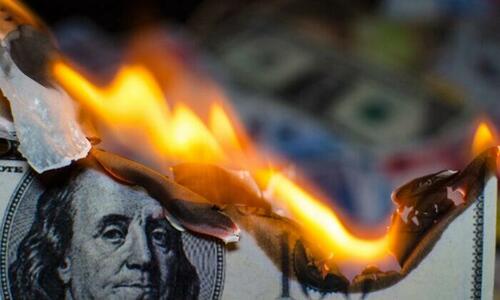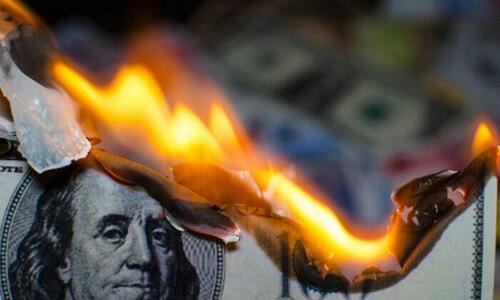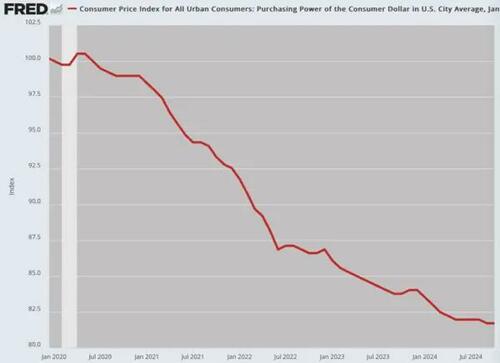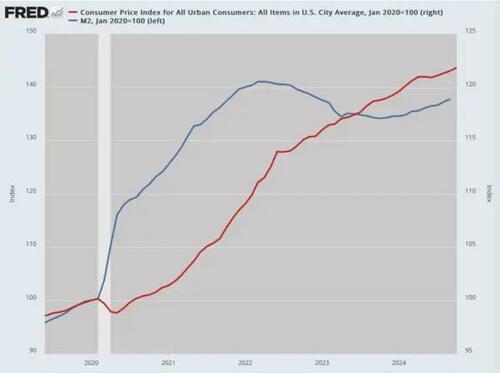A Plan To Tame Inflation
Authored by Jeffrey Tucker via The Epoch Times,
There is finally some chance for honesty now, after four years of gaslighting, especially when it comes to economic conditions. For all this time, we’ve heard nothing from official spokespeople, agencies, and the national media that inflation is cooling, calming, disappearing, improving, and you name the verb. It’s been anything but worsening, at least that’s what we’ve been told.
We emerge from the miasma of these terrible years and what happens? The newest inflation data appears and it is still awful, even worse than before. All told, the U.S. dollar’s purchasing power is down in official data by 22 cents over four years.
That’s what we are being told, and that’s terrible enough. The reality is likely worse once you add in interest rates, shrinkflation, new fees, and housing insurance. That gets us closer to 40 cents and more.
Let us please let go of any doubts about the cause.
Elon Musk summarizes:
“The excess government spending is what causes inflation! ALL government spending is taxation. This is a very important concept to appreciate. It is either direct taxation, like income tax, or indirect via inflation due to increasing the money supply.”
It comes down to the machinery that prints money. Congress authorizes spending, the government mints the debt, and the Fed buys it with money that it creates out of thin air. The result is that all existing monetary units are reduced in value, same as when you mix juice with water.
It’s not that complicated actually, especially when the new money is distributed in the form of direct stimulus payments to individuals and businesses. That’s exactly what happened.
Where do we stand right now? There is some heavy risk of a second wave coming next year. On the current trajectory, that is where we are headed. The Fed has fed another $1.1 trillion in fake money into the system in the last 12 months. The Treasury has created new debt as never before, probably in hopes of ginning up the GDP prior to the election. The trick did not work but now the public is stuck with the bill of $35 trillion.
Inflation is a wicked beast that cannot be controlled directly. On the campaign trail, Trump spoke often about how it was the throttling of the energy sector that kicked off inflation. That is only partially true in the sense that the soaring price of oil and gas grew the costs of transportation. It was also a symptom rather than a cause. Plus, the price of oil and gas is actually not high right now in real terms.
Yes, the plan of “drill baby drill” is necessary and should happen but it cannot fix the existing problem of inflation much less do much to forestall a second wave. Nor is there a viable fix in the idea of price control, even when it is masked as “anti-gouging” legislation.
There is nothing government can do to directly control prices, much less force them from going up given the deep structural problems.
There are ways to mitigate against the problem, or at least minimizing them. You can have a look at how Javier Milei did it in Argentina. He took the problem of massive hyperinflation and converted it to low inflation in a year. His is a case study.
The answer is:
-
end debt creation by dramatic spending cuts,
-
curb the actions of the central bank,
-
and inspire economic growth through deregulation and agency elimination.
That’s three steps.
Let’s consider each.
First, the end of debt creation is essential.
Every time Congress authorizes more spending than is in the bank, the Treasury has to float debt to make it happen. That is the statutory obligation. What that means is that Congress needs to pass a balanced budget, ideally right away.
That comes down to the commission created by Elon Musk: the Department of Government Efficiency or DOGE. It is not an official department. It works as an outside advisory team. That’s excellent. They will likely push for a “Twitter-style” solution of firing 4 in 5 government workers to reduce costs directly.
That’s a start but it is not enough. There also must be sweeping elimination of agencies, each of which can save tens of billions and possibly a trillion or more in total. That needs to happen immediately. It can happen through executive order or through legislation. One way or another, the spending in excess of revenue has to stop.
Trump is not famous for being a budget cutter. He cared nothing for the topic in his first term. He was vulnerable after March 2020 to believing that multiple trillions could be spent without consequence to keep the economy floating during lockdowns. That was an error. He will never admit to it.
This time, however, he has a strong reason to dramatically cut the federal budget. This much he can know for sure: every dime cut from the federal budget is likely to end the flow of money to people who are working to undermine his administration. In saying that, I’m in no way promoting the politics of revenge but rather drawing attention to political realities. Balancing the budget has the side benefit of defunding the opposition.
Second, if the Treasury stops the T-bill tsunami, the Fed will not be called upon to sponge up the excess with money creation.
You can look at the charts over the last year and see how the Biden/Harris administration was spending and working with the Fed to promote more economic illusion going into the election. That was the whole point of the rate cuts. That really must come to an end.
There is a danger that comes with taking away the punch bowl. It could mean a panic by the bond market and a push by the media to announce the Trump Recession.
This is why it is imperative that the Trump team move quickly to explain that right now, the economy is in much worse shape than has been advertised. The pit is very deep and it would be good to dial back expectations of a quick recovery.
We don’t need a falling rate of money growth. We just need stability now. That’s not going to stop the wave of price increases for the next year but it can stop it from getting worse and end it completely by 2026. There is at this point zero need to worry about “deflation,” despite what the financial press will be screaming. Quite frankly, deflation at this point would be a gift to American consumers in any case.
Third, Trump needs to fire up the wealth-creation engine of the American economy through dramatic, sweeping, historic levels of regulation torching plus the shock and awe of full agency elimination, same as in Argentina.
The Trump team needs a list of 100 agencies to eliminate immediately but that should just be a start. Another 100 should be on the chopping block. Without all the regulatory clogging that they cause, investment will soar.
Tax cuts–income and capital–will assist here too. The crucial point is the focus on boosting supply and jobs as a way of outrunning inflationary forces. Here again, the financial press will scream about the economy “overheating” but that metaphor is worn out. The effect of economic growth on inflation is exactly the opposite. Economic growth can bury the effects of price increases.
There is not a lot of time, and it is a bargain that the Trump administration will surely lose if it does not act decisively and quickly. The debt creation and money creation must end and the economic growth through agency elimination and deregulation must become the top priority. All of this has the added advantage of making Trump more popular with the people who elected him.
There is no incompatibility between political success and economic rationality. In this case, the incoming Trump administration is very fortunate: they go together.
Views expressed in this article are opinions of the author and do not necessarily reflect the views of The Epoch Times or ZeroHedge.
Tyler Durden
Thu, 11/14/2024 – 15:45




